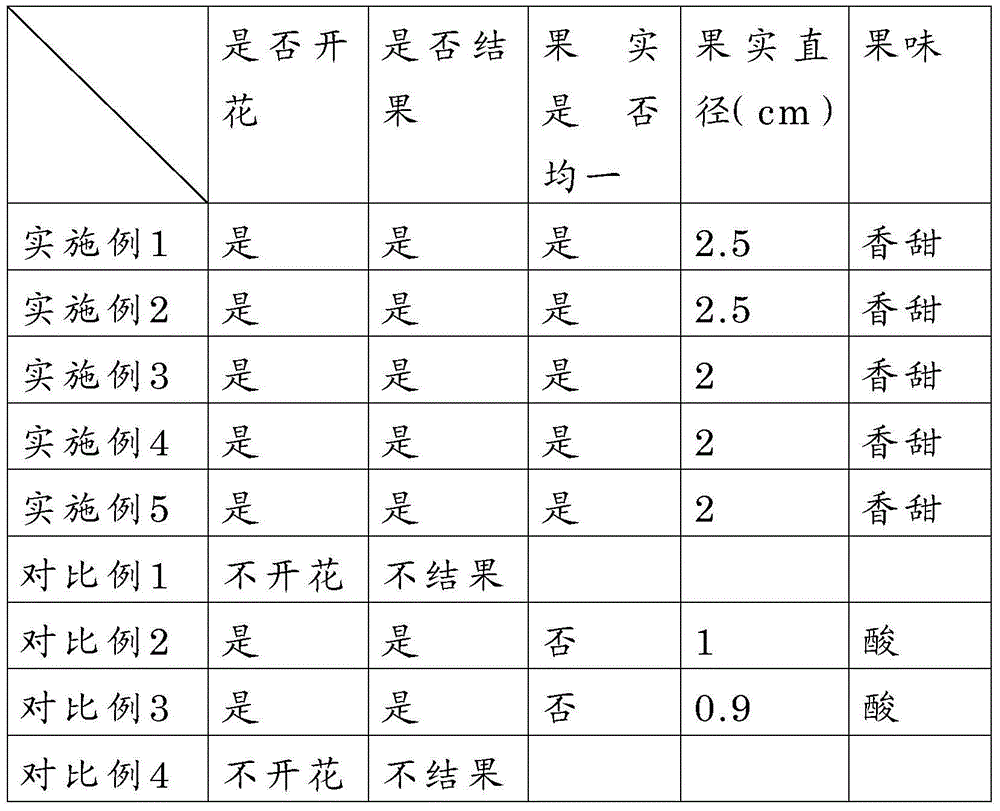Cultivation method of blueberries
A cultivation method, blueberry technology, applied in the direction of cultivation, fertilizer mixture, fertilization device, etc., can solve the problems of declining income, large occupied area, strong restrictions, etc., and achieve the effect of simple cultivation technology, high economic benefit and convenient movement
- Summary
- Abstract
- Description
- Claims
- Application Information
AI Technical Summary
Problems solved by technology
Method used
Image
Examples
Embodiment 1
[0053] (1) On May 10th, a 5-year-old Hokuriku plant was selected in the blueberry production greenhouse. The fruiting rate was 80%. The average diameter of the fruit was 2.5cm and the size was uniform. The fruit did not crack and the fruit tasted sweet;
[0054] (2) On June 15th, after harvesting the fruit of Hokuriku to be selected, it was dug out from the soil and planted in a flower pot. The improved soil was placed in the flower pot. The improved soil consisted of 450g of topsoil and 50g of pot Soil sand, 150g of black soil, 150g of peat, 200g of decomposed old cow dung are mixed evenly, then mixed with 5g of sulfur powder, and stirred evenly;
[0055] (3) After planting, slow down the seedlings at room temperature, pour water twice continuously, subject to watering thoroughly, after 10 days, slow down the seedlings, control the water content of the blueberries to keep them in a dry state;
[0056] (4) On August 22, Hokuriku with flower buds formed was moved into the cold ...
Embodiment 2
[0061] (1) On May 9th, a 5-year-old Hokuriku plant was selected in the blueberry production greenhouse. The fruiting rate was 80%. The average diameter of the fruit was 2.5cm and the size was uniform. The fruit did not crack and the fruit tasted sweet;
[0062] (2) On June 20, after the Hokuriku fruit to be selected was harvested, it was dug out from the soil and planted in a flowerpot. The improved soil was placed in the flowerpot. The improved soil consisted of 450g of topsoil and 50g of pot Soil sand, 150g of black soil, 150g of peat, 200g of decomposed old cow dung are mixed evenly, then mixed with 5g of sulfur powder, and stirred evenly;
[0063] (3) After planting, slow down the seedlings at room temperature, pour water twice continuously, subject to watering thoroughly, after 10 days, slow down the seedlings, control the water content of the blueberries to keep them in a dry state;
[0064] (4) On August 28, Hokuriku with flower buds formed was moved into the cold stora...
Embodiment 3
[0069] (1) On May 2, a 6-year-old Darou plant was selected in the blueberry production greenhouse. The fruiting rate was 70%. The average diameter of the fruit was 2cm and the size was uniform. The fruit did not crack and the fruit tasted sweet;
[0070] (2) On June 18, after harvesting the fruit of Darou to be selected, it was dug out from the soil and planted in a flowerpot. The improved soil was placed in the flowerpot. The improved soil consisted of 450g of topsoil and 50g of pot Soil sand, 150g of black soil, 150g of peat, 200g of decomposed old cow dung are mixed evenly, then mixed with 5g of sulfur powder, and stirred evenly;
[0071] (3) After planting, slow down the seedlings at room temperature, pour water 3 times continuously, subject to watering thoroughly, after 10 days, slow down the seedlings to complete, control the water content of the blueberries to keep them in a dry state,
[0072] (4) On August 25, the Darou with flower buds formed was moved into the cold ...
PUM
| Property | Measurement | Unit |
|---|---|---|
| The average diameter | aaaaa | aaaaa |
| The average diameter | aaaaa | aaaaa |
| The average diameter | aaaaa | aaaaa |
Abstract
Description
Claims
Application Information
 Login to View More
Login to View More - R&D
- Intellectual Property
- Life Sciences
- Materials
- Tech Scout
- Unparalleled Data Quality
- Higher Quality Content
- 60% Fewer Hallucinations
Browse by: Latest US Patents, China's latest patents, Technical Efficacy Thesaurus, Application Domain, Technology Topic, Popular Technical Reports.
© 2025 PatSnap. All rights reserved.Legal|Privacy policy|Modern Slavery Act Transparency Statement|Sitemap|About US| Contact US: help@patsnap.com

